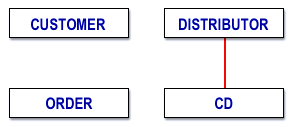This exercise is worth a total of 20 points.
You will receive up to five points for each correct answer to the questions listed below.
- Background and Overview
In the preceding lesson, you learned that entity relationships are associations between entities. You also learned that simply knowing an association exists between entities reveals very little; that you must also know the type of relationship and
type of participation that exist between entities in order to establish relationships.
- Instructions
The four entities (CUSTOMER, ORDER, CD, DISTRIBUTOR) for Stories on CD, Inc. participate in relationships with each other.
Based on this knowledge, answer the following questions using this basic format for each response:
The VENDOR entity participates in a relationship with the PRODUCT entity.
- What relationship(s) does the CUSTOMER entity directly participate in?
- What relationship(s) does the ORDER entity directly participate in?
- What relationship(s) does the CD entity directly participate in?
- What relationship(s) does the DISTRIBUTOR entity directly participate in?
- Hints
The easiest way to determine entity relationships is with a sketch. Below is a partial sketch to get you started. If you transfer this sketch to a sheet of paper and (correctly) draw in the lines, you will have the answers to the exercise. Keep in mind that only those entities with a line drawn between them are directly participating in that particular relationship.
 Entity relationships initial sketch consisting of 1)CUSTOMER 2) DISTRIBUTOR 3)ORDER 4)CD
Entity relationships initial sketch consisting of 1)CUSTOMER 2) DISTRIBUTOR 3)ORDER 4)CD